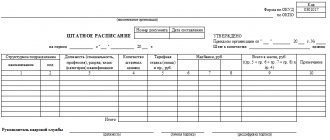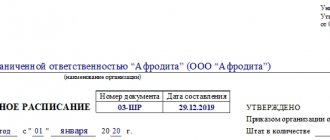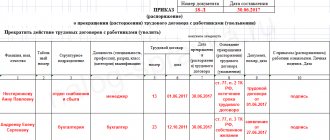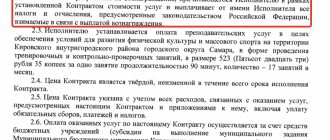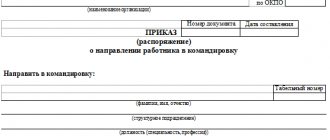The staffing table is an official document of a legal entity, which is compiled by the human resources department, accounting department or economists for each year, and signed by the head of the enterprise. On the basis of it, employment contracts are concluded with employees of the organization, various plans are drawn up, and it is also part of the mandatory list of documents provided during audits of the company and legal proceedings. The document can be drawn up either according to the unified T-3 form, or according to a independently created form, which must contain certain data. An example of a staffing table is given below; at the end of the article you can download the necessary forms.
Staffing: unified form T-3
From January 1, 2013, commercial organizations are not required to draw up personnel documents according to approved forms, that is, they can use independently developed document forms.
For more information about this, see the article “Primary document: requirements for the form and the consequences of its violation” .
However, the unified T-3 form is a fairly convenient and familiar way of designing the staffing arrangement. In addition, the staffing table of the T-3 sample form contains all the necessary information, so most employers continue to use this particular form of document.
Let us remind you that the staffing table - a form of the unified form T-3 - and the procedure for filling it out were approved by Decree of the State Statistics Committee of the Russian Federation dated January 5, 2004 No. 1. In order for users of our site to know how to draw up a staffing table, a sample document is presented in its pure form (in this section) and in the completed state (in the last section).
What information does the unified staffing form contain?
The staffing table is one of the internal regulatory documents that every organization (or entrepreneur with employees) must have.
What other personnel documents should the employer prepare, read the article “Personnel documents that must be in the organization.”
The staffing table contains:
- list of structural divisions;
- names of positions, specialties and professions indicating qualifications;
- information on the number of staff units;
- information on salaries: tariff rates and salaries, bonuses, wage fund (payroll), including for the organization as a whole.
The main purpose of the staffing table is to determine the structure, staffing levels and size of the payroll. The document does not contain the names of employees and their staffing positions. The staffing arrangement (synonyms: staff replacement, staff list) is not established by regulatory documents. Staff replacement, unlike the staffing table, is not a mandatory document for the organization, however, it is often used. This is due to the fact that full-time replacement allows you to track vacancies, as well as the filling of staff positions when hiring a part-time employee or if the position is divided between several employees. Staff replacement is usually developed on the basis of the staffing table of the T-3 form with the addition of a column in which the last names, first names, and patronymics of employees occupying certain positions are entered. If an organization uses staff replacement in its activities, then it must be taken into account that this document must be stored for 75 years.
ConsultantPlus experts explained in detail how the staffing arrangement is drawn up. Get trial demo access to the K+ system and go to the HR Guide for free.
Read about retention periods for personnel documents here.
Why make up a “staff”
First of all, the document is necessary for planning. At its core, a staffing table is a list of positions, information about the number of staff units, official salaries, allowances, and the monthly salary fund in the company. ShR structures the entire organization and the hierarchy within it. The document shows how many departments there are in the company, what governing bodies are provided and what direction is a priority. Having the schedule form at hand, anyone can easily form an opinion about the average number of employees, the monthly payroll and the type of activity of the company.
Based on this local act, it is very convenient to form a wage fund, confirm the validity of expenses for the Federal Tax Service, draw up statistical reports and applications to the employment service and recruitment agencies. By the way, it is important to remember that if a position is designated in the SR, then it must be occupied. If there is a vacancy, but there is no employee, the employment service should know about it. Otherwise, upon learning of the violation, they will be punished. This follows from the provisions of the Law of the Russian Federation of April 19, 1991 No. 1032-1 on employment.
In practice, HR is necessary in the work not only of personnel officers, but also of accountants. “Statka” is one of the forms that is most often required during tax audits, as it is a primary accounting document. When drawing up the document, it is necessary to take into account all the requirements of labor legislation and the internal needs of the employing organization.
ConsultantPlus experts have prepared a detailed guide to working with staffing. We figured out not only how to fill it out, but also how to store it, how to provide it to inspectors, and how to make extracts. Use these instructions for free.
How to properly draw up a staffing schedule
Drawing up the staffing table can be entrusted to any employee of the organization, and it must be approved by order (instruction) of the manager or other authorized person. If changes are needed to the staffing table, an order to amend the staffing table is issued. The procedure for issuing documents on approval of the staffing table must be enshrined in the constituent documents.
Read about the nuances of drawing up such orders in the material “Orders for core activities - what are these orders?”
When drawing up the staffing table for the first time, it is assigned the number 1, and subsequently continuous numbering is used. The staffing table indicates the date of preparation, as well as the date from which the staffing table comes into effect. These two dates may vary. Form T-3 provides an indication of the period of validity of the staffing table, details of the order for its approval and the number of staffing units.
Validity
The company can choose the validity period of the staffing schedule independently. In most cases it is drawn up for 1 year. If the organization is small, with a small number of employees and is not actively developing, then the staffing table can function for several years. In large organizations whose staff is growing rapidly, the document is filled out annually.
If new positions appear throughout the year, the number of staff positions, vacancy names, and salaries change, then amendments and additions can be made to the document. This is done by issuing a special order (we will discuss it below) and introducing changes to the ShR.
Code of the structural unit in the staffing table and other information
The staffing table in the tabular section begins to be filled out by indicating the names and codes of structural divisions. As a rule, the department code in the staffing table is indicated in an order that allows one to determine the subordination and structure of the entire organization.
If an organization has branches and representative offices, then it must be taken into account that they are a structural unit of the organization, and accordingly, the staffing table should be drawn up for the organization as a whole. Even if the head of the branch has been given the right to independently approve the staffing table, it is still drawn up as part of a single staffing table. ConsultantPlus experts explained how the T-3 form is filled out in this case. You can get a free trial access to the system and study authoritative opinion.
Column 3 of the staffing table contains the name of the position, specialty, profession, which are indicated in the nominative case without abbreviations. The name of the position or profession is assigned by the employer, if the work is not associated with difficult working conditions and the provision of benefits, otherwise, when indicating the position in the staffing table, you need to be guided by:
- for the All-Russian Classifier of Worker Occupations, Employee Positions and Tariff Classes (OK 016-94) (approved by Resolution of the State Standard of Russia dated December 26, 1994 No. 367);
- All-Russian Classification of Occupations (OKZ) OK 010-2014 (MSKZ-08) (approved by order of Rosstandart dated December 12, 2014 No. 2020-st);
- Qualification reference book for positions of managers, specialists and other employees (approved by Resolution of the Ministry of Labor of Russia dated August 21, 1998 No. 7);
- unified tariff and qualification directories of works and professions of workers by industry;
- professional standards (paragraph 3, part 2, article 57, article 195.1 of the Labor Code of the Russian Federation).
How to bring job titles into line with professional standards, read here.
If an organization hires employees to perform a certain type of work, and not for a position (profession, specialty), then this also needs to be reflected in the staffing table.
Next, in column 4 of the staffing table, the number of staff units is indicated. Staffing units can be indicated as full or incomplete. The content of an incomplete staff unit in the staffing table is indicated in shares, for example 0.25; 0.5; 2.75, etc.
When drawing up the staffing table, special attention should be paid to column 5 “Tariff rate (salary), etc., rub.” In the simplest case, this column of the staffing table indicates a fixed monthly wage.
In practice, when drawing up a staffing table, the question often arises about the correct execution of the document in situations where there is no fixed amount of remuneration, for example, with piecework payment. In this case, it is recommended to put a dash in column 4 of the staffing table, and in column 10 indicate: “Piece-piece wages / Piece-piece bonus wages” and provide a link to the local regulatory act that defines the procedure for establishing wages, as well as its amount for a certain standard production. It is recommended to follow a similar procedure when filling out the staffing table in a situation where the employee has an hourly wage rate.
If the staffing table provides for an incomplete staffing position, then in the column “Tariff rate (salary)” the amount of the full salary for the position is still indicated.
Order for amendments
Form of order to change the staffing table in *doc (Word) format.
The order to make changes is drawn up in free form and the following details must be indicated in it:
- Name of the organization.
- Document type.
- Registration date and number.
- Stamp with the inscription "Approved".
- Executive visas.
The order is agreed upon with the chief accountant and manager.
Change due to elimination of positions
It is possible to exclude a position from the staffing table only if there is a reduction in personnel. To do this, an order to make changes is issued, the position is deleted and a new staffing table is approved.
You can exclude a certain position only if certain conditions arise, such as:
- A crisis.
- Change of working conditions and more.
When reducing staff, the dismissed employee is given two months' notice before the reduction.
Procedure for reducing staff and changing the staffing table:
- Drawing up an order (it indicates the reason for its issuance and specifies the name of the position that is being excluded). The document is certified.
- Changes are made to the current staffing table without deleting job codes and structural units.
- An order is drawn up on measures to reduce personnel. The order is certified and the laid-off employees are familiarized with it.
Introduction of a new position
In order to introduce a new position into the staffing table you must:
- Draw up an order for changes to the schedule.
- Make changes to the staffing table.
- Create a job description for a new employee.
How to fill out a staffing table: sample and example
A sample of filling out the staffing table of Form T-3 in a situation where there is no fixed salary, and there is also an incomplete staffing position, can be found on our website.
NOTE! In Art. 22 of the Labor Code of the Russian Federation states that payment should be equal for equal work. It follows from this that the “fork” of salaries in the staffing table is a violation of the Labor Code. Rostrud, in letter No. 1111-6-1 dated April 27, 2011, recommends that the same salary amounts be indicated in the staffing table for positions of the same name, and that the possibility of paying one of the employees wages (not salary) in a larger amount should be regulated through allowances and additional payments depending on the complexity work, quantity and quality of labor.
In columns 6, 7, 8 “Additional allowances, rub.” allowances are indicated - both accepted in the organization (for long working hours, increased responsibility, knowledge of foreign languages, work experience, etc.) and established at the legislative level (for example, for work in the Far North). The staffing table of the unified form assumes that these columns are filled in in rubles. If there are not enough columns to indicate all the allowances in force in the organization in the staffing table, then their number can be increased by issuing an order to supplement the staffing table form. It is recommended to do the same if the premiums are set as a percentage.
Column 9 “Total for the month” is filled out only if the salary and allowances are indicated in rubles. The instructions for drawing up the staffing table state that “if it is impossible for an organization to fill out columns 5–9 in ruble terms... the columns are filled in in the appropriate units of measurement (percentages, coefficients, etc.).” However, it is impossible to actually formalize the staffing schedule in this way. In such a situation, you can put dashes in this column, and in column 10 “Note” indicate a link to regulations, both internal and regulatory, that establish premiums. The link in column 10 to the document allowing you to set an increase for length of service will allow you not to change the schedule when the amount of the increase changes. Column 10 also indicates any information related to the staffing table.
In some situations, an employee may need an extract from the staffing table. A sample of filling out such an extract was prepared by ConsultantPlus experts. If you do not have access to the K+ system, get a trial demo access for free.
Nuances of registration and changes to the staffing table
The unified form T-3 requires the signatures of the head of the personnel service and the chief accountant, but it does not contain such requisites as a seal.
The frequency and timing of approval of the staffing table are not established by law, and each employer decides this issue independently.
Familiarization with the staffing table of employees is carried out only if this obligation of the employer is secured by a collective agreement, agreement, or local regulatory act (letter of Rostrud dated May 15, 2014 No. PG/4653-6-1).
Changes may be made to the staffing table if it is necessary to supplement it with new positions and structural divisions or, conversely, to exclude them, as well as when changing salaries, renaming departments and positions. Changes in the staffing table are formalized by order. There are 2 ways to make changes to the staffing table:
1) issuing an order on the corresponding change;
2) issuance of an order approving a new staffing table.
When reducing staff or numbers, or changing salaries, changes are also made to the staffing table, but it must be taken into account that the date of entry into force of the changes cannot occur earlier than 2 months after the issuance of the order. This is due to the fact that employees must be notified 2 months in advance about the upcoming layoff (Part 2 of Article 180 of the Labor Code of the Russian Federation) or about upcoming changes in the terms of employment contracts.
The staffing table is kept permanently in the organization. Organizations carrying out control and supervisory functions (for example, the labor inspectorate, regulatory bodies of the Federal Social Insurance Fund of the Russian Federation, the Pension Fund of the Russian Federation, tax authorities) have the right to request this document when conducting inspections. In case of failure to provide the documents or copies thereof requested by the controllers, including the staffing table, the employer may be subject to a fine of 200 rubles. for each document not submitted (clause 1 of Article 126 of the Tax Code of the Russian Federation).
FORMATION AND APPROVAL OF THE ENTERPRISE STAFF SCHEDULE
The staffing table is formed by any employee who is assigned the corresponding responsibility. As a rule, this is done by HR specialists (HR department, labor and wages department, HR department), less often by specialists from the accounting or financial department.
IT IS IMPORTANT
Before you begin to create a staffing table, decide on the organizational structure of the enterprise. This step is not mandatory, but it greatly facilitates further work.
The organizational structure of an enterprise is a complex of relationships between various levels of the organization, aimed at the optimal distribution of responsibilities and degrees of subordination.
Elements of the organizational structure of the enterprise:
- workers;
- departments, bureaus, divisions and other internal services.
The basis of the relationship between the elements of the organizational structure is horizontal and vertical connections.
Horizontal connections are single-level and have the nature of coordination. They are built between divisions of an enterprise that are at the same management level (not subordinate to each other). Vertical connections presuppose the existence of subordination and leadership.
There are several main forms of enterprise management:
- linear;
- functional;
- linear-functional.
Linear form of control
The linear management structure presupposes the presence of a single manager, subordinate to whom are executives or heads of departments (line managers). Here are present:
- vertical connections from the main manager to the heads of departments and from the head of departments to the performers in this department;
- horizontal connections only from one department head to another. There are no horizontal connections between performers in different departments.
Functional form of management
The functional form of management is a consequence of the linear one, when there is a need for specialization of enterprise divisions. In this case, functional responsibilities are distributed between departments and performers.
Linear-functional form of management
Combining the basics of linear and functional forms of management, this structure presupposes the presence of both functional and line managers. Functional managers set tasks for line managers, who can subsequently delegate them to their subordinates.
The functional manager supervises several line managers of departments of the enterprise (for example, the deputy director for economics and finance can supervise the heads of the economic planning department, the labor and wages department, and the accounting department).
In addition to the presented management structures, there are line-staff forms, divisional, project, matrix and brigade.
Line-staff management structure
Line-staff structure - development of a linear structure. This management structure includes special units, the so-called headquarters. They do not have the right to make decisions and manage lower-level units, they are intended to assist in the implementation of any tasks, and carry out planning and analysis. In other words, headquarters units perform functions that were not previously assigned to line managers under a simple linear management structure.
Divisional management structure
In a divisional structure, a distribution of duties and responsibilities is assumed: senior management is engaged in planning and solving strategic problems, and division heads are responsible for operational decisions (at the same time, they are responsible for making a profit for their division).
Project management structure
The project form refers to the organic (flexible, adaptive) type of enterprise management. The basic principle of this form: the creation of temporary management bodies to solve specific problems (for a specific project). After completing the assigned tasks, the unit is usually disbanded.
Matrix management structure
Similar to the project form, in matrix management, project units are created, but here their managers report to the functional manager, and the performers of these units are dually subordinate (to the project and functional manager).
Brigade management structure
The brigade form is very similar to the matrix form, only it is based on a group form of labor organization. The use of this form involves the creation of autonomous teams, which consist of management, specialists and labor.
It should be noted that the linear-functional structure of enterprise management is most widespread.
Using the organizational structure of an enterprise, creating a staffing table is much easier.
There is not a word in the current legislation that all enterprises, without exception, are required to draw up a staffing table. At the same time, it does not indicate the absence of such an obligation. Thus, formation is not mandatory, but this does not mean that it can be neglected.
Situations often arise when higher authorities (labor inspectorate, judicial authorities, tax service, etc.) may request a staffing table or an extract from it (goals: to check the validity of the application of tax benefits, the reliability of the information provided on work experience, earnings, etc. ).
Results
The staffing table is a mandatory document that any employer must have. An example of filling out a staffing table using Form T-3 can be found on the Internet on many accounting and legal websites, but a sample with the situations described above is rarely provided. When preparing the staffing table, form T-3, a sample of which is given in this article, can be a good help for both experienced and novice personnel officers.
To learn how to properly organize personnel records, read the article “Personnel records management from scratch - step-by-step instructions.”
You can find more complete information on the topic in ConsultantPlus. Free trial access to the system for 2 days.
Order of approval
The staffing table must be approved by the heads of all structural divisions or individual employees in management positions. After this, the staffing table is sent for review to the chief accountant and the head of the personnel department.
After the staffing table is approved by the accountant and the head of the personnel department, the manager issues an order to approve the new schedule.
When the order is issued, the date and number are indicated in the staffing table.
